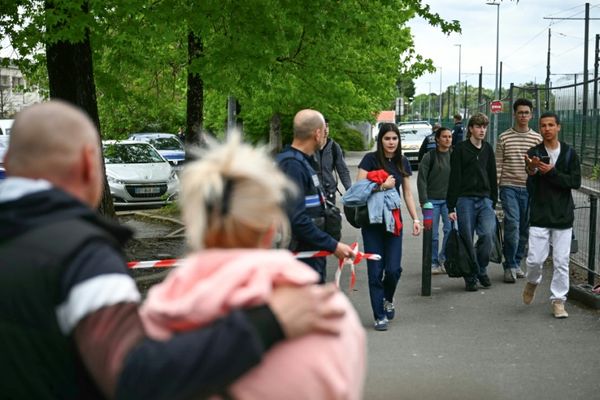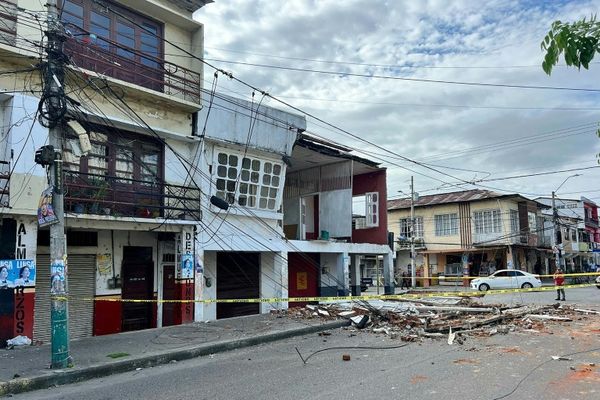
Mary Lattimore, of Los Angeles, plays the least mobile instrument in the world – the harp. Hers is six feet tall and heavy, a beautiful whale of a thing made of wood and strings. “Gigantic,” she says. Earlier this year she wanted to go to the other side of the world to make a record. But how to get a harp from California to Cornwall, UK?
It wasn’t possible. She avoids taking it even on big planes and this trip – to the secluded, windswept studio of Slowdive founder Neil Halsted – involved a light plane as well, from London to Newquay, a fishing, surfing and farming town on the Cornish coast.
This is not a flute, which fits in one’s back pocket.
“I decided we would hire one near Cornwall,” Lattimore says, from LA, over Zoom. She’s sitting on the floor in a sun-filled room with wall hangings. “But it turned into a desperate search. I was talking to twenty harpists but they couldn’t come or they were busy or playing or needed their harp. Then we found Tim, a student. He saved the day. He drove down with his Dad to deliver the harp. It was a beautiful harp.”
The record is called Silver Ladders, released by arthouse New York label Ghostly. Lattimore’s mother Lelia was until recently a classical harpist with a symphony orchestra in North Carolina; now she’s a teacher. She has played for 30 years – “…she gave me no choice,” says Lattimore. “It was her dream. She loves the harp, it’s her favourite thing in the world. All her friends are harpists. She’s an advocate for the instrument. She definitely wanted her first daughter to play.”
Hearing a harp in 2020 as a pandemic kills more each day and global politics becomes increasingly ludicrous is jarring, almost, at first. A shock. It is such a deeply beautiful sound; Lattimore likes to play hers through loop and delay pedals making it somehow more hypnotic and soothing, a sort of intricate calm, full of mystery and a sense of unknowing. A perfect antidote to the times; I’ve had Silver Ladders on repeat for much of Melbourne’s lockdown, not to distract but to, I guess, rise above. To feel and be within some magic.
Lattimore was first noticed by the US independent rock scene when she was helping Kurt Vile write songs and touring with him. She has since played with Thurston Moore of Sonic Youth, Beck and Arcade Fire, and made six albums of mostly instrumental, millennial harp music (including last year’s New Rain Duets, with Mac McCaughan of Superchunk). So she’s very much of indie-rock and post-rock, but also a total outlier.
Her decision to use Halsted to help her make the music sound better was inspired. His band Slowdive – darlings of the 1990’s ‘shoegaze’ movement with Ride and My Bloody Valentine – elevated guitars to an overdriven, highly melodic wall of sound, sweet and pure. Some of these bands were the loudest in a generation. Yet Halsted, a softly-spoken, lushly bearded surfer and songwriter, now makes folk. Neither knew what results they would get. Lattimore has never worked with a producer and Halsted had never encountered a harp. But then there she was, in Cornwall, in winter.
“It was February, just before (the first) lockdown in the UK,” Halsted says. He’s also on the Zoom call, also sitting on the floor, in front of his fire at home, with his dog. “Miserable, storms, rain, dark cloudy days. I won’t say desolate but it’s a lonely landscape, a dramatic landscape.”
Lattimore stayed up the road at the spooky Headland Hotel, built in 1900 and the location for the film The Witches, by Roald Dahl, in the 80’s. She has talked about the wild landscape, the ghosts of dead surfers, the moon shining on the ocean at night. Halsted’s studio is in an old hospital block of a WW1 airfield, surrounded by hangars. The record seems to respond to the landscape,” he says. As well as playing occasional guitar and synth, Halsted has given Silver Ladders a depth not as present in her previous six albums.
“For me it was lovely to approach something completely new,” he says. “I had never been close to a harp before. I had no idea what Mary wanted from me. Apart from producing my own solo records, I don’t produce anything. When I make records I usually take a really long time so when Mary said she was going to come over for ten days I thought ‘we’ll see about that.’ But it was brilliant, she is an amazing improviser. It was brilliant for me to have her sit down and play her harp. The only thing I thought was to make this new one a bit darker than the others, maybe? I felt like I could hear her sounding more minimal and dark.”
One thing he has done is boost the bottom end, a timbre less audible in the instrument’s journey through medieval, baroque, classical and folk canons. It sounds vast and fathoms-deep, like the weather, the view, the ever-moving sea. The earliest harps were found in the Middle East and dated to 3500BC. It is an instrument found in most ancient musical cultures; the coat of arms of Ireland is a harp. Christian motifs have angels in heaven playing harps. Here on Silver Ladders there’s a sense of the ancient and modern not colliding but intermingling; I think of the music of Alice Coltrane, Sigur Ros and the outermost experiments of Bjork. It’s wonderful, inclusive music with no name or popular form, no words, no indications of anything except itself and how it sounds.
“I made the last couple of records by myself and I think that was part of the problem,” Lattimore says. “I’m not very technologically gifted. I use GarageBand and pedals only, I am very primitive and I got myself kind of stuck? That’s why I wanted to hang out with someone who has a sonic palette that I love and knows how to do things differently. I had this way I wanted the harp to sound in my mind but I didn’t know how to get there. That was the beauty of us working together – I could say ‘can you make this melty? Can you make this washed out? Can you make this watercolour?’ For me it’s a feeling more than knowing how to do it.”
Much of the process involved Lattimore playing – improvising – and then editing the improvisation with Halsted at the controls. “Manipulate certain parts,” she says. “Remove, accentuate. The magic is in the chance. Layers ricocheting off other layers.”
Chris Johnston is a Melbourne writer and author specialising in culture and cults. Twitter @mrcjohnston.
Support quality journalism.
As an inkl member you can directly support the work of journalists like Chris, while also getting access to 100+ publications like Foreign Affairs, The Independent, The Economist, Financial Times and Bloomberg.
As part of our commitment to building a sustainable future for journalism, a portion of your monthly inkl membership fee will go directly to Chris for as long as you remain a subscriber.
BECOME A MEMBER






